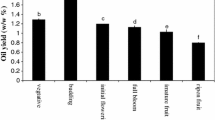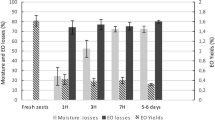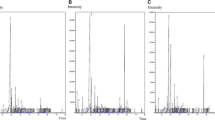Abstract
The essential oil yield and composition of the different growth stages of C. verum leaves were investigated. The results indicated that the density of the oil cells and the degree of oil accumulation were closely related to the essential oil yield. The leaves of the 2-year-old branches contained the highest density of oil cells (10.17 n/mm2), and the oils were largely accumulated, which coincided with the highest oil yield (5.81 %). The oils were less accumulated in leaves 1–4 collected from the annual branches and were mostly disintegrated in the leaves collected from the 4-year-old branches, resulting in lower oil yields (3.04 and 2.98 %, respectively). Eugenol was primarily found in the leaves collected from the 1-year- old branches, and the eugenol content decreased with the leaf growth. The results indicated clearly, that the leaves collected from the 1- and 2-year-old branches should be preferably chosen as the raw materials for the extraction of high-quality essential oils or eugenol. These results provide reference information for the rational utilization of cinnamon resources. Our research indicated that GC–MS and FTIR techniques, combined with microscopy, has been proved to be an effective strategy for assessment of essential oil quality for use in cinnamon plants.







Similar content being viewed by others
References
Adams RP (2001) Identification of essential oil components by gas chromatography/quadrupole mass spectroscopy. Allured Publishing Corporation, Carol Stream, IL, USA
Amaral LP, Tondol JSM, Schindler B, Silva DT, Pinheiro CG, Longhi SJ, Mallmann CA, Heinzmann BM (2015) Seasonal influence on the essential oil production of Nectandra megapotamica (Spreng.) Mez. Braz Arch Biol Technol 58:12–21
Argyropoulou C, Daferera D, Tarantilis PA, Fasseas C, Polissiou M (2007) Chemical composition of the essential oil from leaves of Lippia citriodora H.B.K. (Verbenaceae) at two developmental stages. Biochem Syst Ecol 35:831–837
Buchgraber M, Ulberth F, Anklam E (2004) Cluster analysis for the systematic grou** of genuine cocoa butter and cocoa butter equivalent samples based on triglyceride patterns. J Agric Food Chem 52:3855–3860
Cai JB, Lin P, Zhu XL, Su QD (2006) Comparative analysis of clary sage (S. sclarea L.) oil volatiles by GC–FTIR and GC–MS. Food Chem 99:401–407
China Pharmacopeia Commission (2010) Pharmacopoeia of the People’s Republic of China 2010, vol 1. Chinese medical science and technology press, Bei**g, China, pp 63–127
De Guzman CC, Siemonsma JS (1999) Plant resources of South East Asia. 13. Spices. Backhuy’s Publishers, Leiden
Deng XJ, Liao QF, Xu XJ, Yao MC, Zhou YT, Lin MN, Zhang PT, **e ZY (2014) Analysis of Essential Oils from Cassia Bark and Cassia Twig Samples by GC-MS Combined with Multivariate Data Analysis. Food Anal Methods 7:1840–1847
Dey BB, Choudhuri MA (1983) Effect of leaf development stage on changes in essential oil of Ocimum sanctum L. Biochem Physiol Pflanz 178:331–335
Dudai N, Chaimovitsh D, Reuveni R, Larkov O, Putievsky E (2002) Breeding of sweet basil (Ocimum basilicum) resistant to Fusarium wilt caused by Fusariun oxysporum f. sp. basilicum. J Herbs Spices Med Plants 9:45–51
Dudai N, Larkov O, Ravid U, Putievsky E, Lewinsohn E (2001) Developmental control of monoterpene content and composition in Micromeria fruticosa (L.) Druce. Ann Bot 88:349–354
Fischer R, Nitzan N, Chaimovitsh D, Rubin B, Dudai N (2011) Variation in essential oil composition within individual leaves of Sweet Basil (Ocimum basilicum L.) is more affected by leaf position than by leaf age. Agr Food Chem 59:4913–4922
Gang DR, Wang JH, Dudareva N, Nam KH, Simon JE, Lewinsohn E, Pichersky E (2001) An investigation of the storage and biosynthesis of phenylpropenes in basil. Plant Physiol 125:539–555
Gershenzon J, McConkey ME, Croteau RB (2000) Regulation of monoterpene accumulation in leaves of peppermint. Plant Physiol 122:205–213
James SA, Bell DT (1995) Morphology and anatomy of leaves of Eucalyptus camaldulensis clones: variation between geographically separated locations. Aust J Bot 43:415–433
Jayaprakasha GK, Jagan Mohan Rao L (2011) Chemistry, Biogenesis, and Biological Activities of Cinnamomum zeylanicum. Crit Rev Food Sci Nutr 51:547–562
Jayaprakasha GK, Negi PS, Jena BS, Jagan Mohan Rao L (2007) Antioxidant and antimutagenic activities of Cinnamomum zeylanicum fruit extracts. J Food Compos Anal 20:330–336
Joy PP, Thomas J, Mathew S, Ibrahim KK (1998) Growth, leaf oil yield and quality investigations in Cinnamon (Cinnamomum verum). Journal of Medicinal and Aromatic Plant Sciences 28:401–406
Kaneria MJ, Bapodara MB, Chanda SV (2012) Effect of extraction techniques and solvents on antioxidant activity of Pomegranate (Punica granatum L.) leaf and stem. Food Anal Methods 5:396–404
Koeduka T, Fridman E, Gang D, Vasso D, Jackson B, Kish C, Orlova I, Spassova S, Lewis N, Noel J, Baiga T, Dudareva D, Pichersky E (2006) Eugenol and isoeugenol, characteristic aromatic constituents of spices, are biosynthesized via reduction of a coniferyl alcohol ester. Proc Natl Acad Sci U S A 103:10128–10133
Lawrence B, Farbman M (1984) Feasiblbility study for Cinnamon processing in the Seychelles. A Report to the U.S. Agency for International Development Nairobi, Kenya pp.1–90
Li H, Madden JL (1995) Analysis of leaf oils from a Eucalyptus species trial. Biochem Syst Ecol 23:167–177
Li H, Madden JL, Potts BM (1996) Variation in volatile leaf oils of the Tasmanian Eucalyptus species II subgenus Symphyomyrtus. Biochem Syst Ecol 24:547–569
Li YQ, Kong DX, Huang RS, Huang HL, Xu CG, Wu H (2013a) Variations in essential oil yields and compositions of Cinnamomum cassia leaves at different developmental stages. Ind Crop Prod 47:92–101
Li YQ, Kong DX, Wu H (2013b) Analysis and evaluation of essential oil components of cinnamon barks using GC–MS and FTIR spectroscopy. Ind Crop Prod 41:269–278
List S, Brown PH, Walsh KB (1995) Functional anatomy of the oil glands of Melaleuca alternifolia (Myrtaceae). Aust J Bot 43:629–641
Lorenz-Fonfria VA, Padros E (2004) Curve-fitting of Fourier manipulated spectra comprising apodization, smoothing, derivation and deconvolution. Spectrochim Acta Part A-Mol Biomol Spectrosc 60:2703–2710
Mallavarapu GR, Ramesh S, Chandrasekhara RS, Rajeswara Rao BR, Kaul PN, Bhattacharya AK (1995) Investigation of the essential oil of cinnamon leaf grown at Bangalore and Hyderabad. Flavour Fragr J 10:239–242
Moarefian M, Barzegar M, Sattari M (2013) Cinnamomum zeylanicum essential oil as a natural antioxidant and antibactrial in cooked sausage. J Food Biochem 37:62–67
Neish AC (1960) Biosynthetic pathways of aromatic compounds. Ann Rev Plant Physiol II:55–80
Paul SC, Sahoo S (1993) Selection of elite cinnamon plants for quality bark production. J Econ Taxon Bot 17:353–355
Platt-Aloia KA, Thomson WW (1992) Idioblast oil cells of avocado: distribution, isolation, ultrastructure, histochemistry, and biochemistry. Int J Plant Sci 153:301–310
Ravindran PN, Nirmal Babu K, Shylaia M (2004) Cinnamon and Cassia (The genus Cinnamomum). The Chemical Rubber Company Press, Boca Raton, USA, pp 1–37
Sahoo S, Paul SC, Patra P (2000) Quality cinnamon production in India. Med Aromat Plant Sci 22:361–365
Sangwan NS, Farooqi AHA, Shabih F, Sangwan RS (2001) Regulation of essential oil production in plants. Plant Growth Regul 34:3–21
Santos-Gomes PC, Fernandes-Ferreira M, Vicente AMS (2005) Composition of the essential oils from flowers and leaves of Vervain (Aloysia triphylla (L’Herit.) Britton) grown in Portugal. J Essent Oil Res 17:73–78
Singh N, Luthra R, Sangwan RS, Thakur RS (1989) Metabolism of monoterpenoids in aromatic plants. Curr Res Med Aromat Plants 11:174–197
WHO (1999) Cortex Cinnamomi. In: WHO Monographs on Selected Medicinal Plants. World Health Organization, Geneva, pp.95–1040
Wijesekera ROB (1978) The chemistry and technology of Cinnamon. CRC Crit Rev Food Sci Nutr CRC Critical Review in Food Science and Nutrition 10:1–30
Zygadlo JA, Lamarque AL, Maestri DM, Guzman CA, Lucini EI, Grosso NR, Ariza-Espinar L (1994) Volatile constituents of Aloysia triphylla (L’Herit.) Britton. J Essent Oil Res 6:407–409
Acknowledgments
We wish to thank Mr. Lei Fan for their technical assistance. The authors wish to thank Guiqing Li for their assistance in collecting the cinnamon samples. This study was supported by the PhD Start-up Fund of Natural Science Foundation of Guangdong Province (2014A030310433), China and the Science and Technology Innovation Fund Project on Forestry of the Guangdong Province (2012KJCX015-06).
Conflict of Interest
Yanqun Li declares that he has no conflict of interest. Dexin Kong declares that she has no conflict of interest. **aoman Lin declares that she has no conflict of interest. Zhaohong **e declares that he has no conflict of interest. Mei Bai declares that he has no conflict of interest. Shushi Huang declares that he has no conflict of interest. Hai Nian declares that he has no conflict of interest. Hong Wu declares that he has no conflict of interest. This article does not contain any studies with human or animal subjects.
Author information
Authors and Affiliations
Corresponding author
Rights and permissions
About this article
Cite this article
Li, Y., Kong, D., Lin, X. et al. Quality Evaluation for Essential Oil of Cinnamomum verum Leaves at Different Growth Stages Based on GC–MS, FTIR and Microscopy. Food Anal. Methods 9, 202–212 (2016). https://doi.org/10.1007/s12161-015-0187-6
Received:
Accepted:
Published:
Issue Date:
DOI: https://doi.org/10.1007/s12161-015-0187-6




